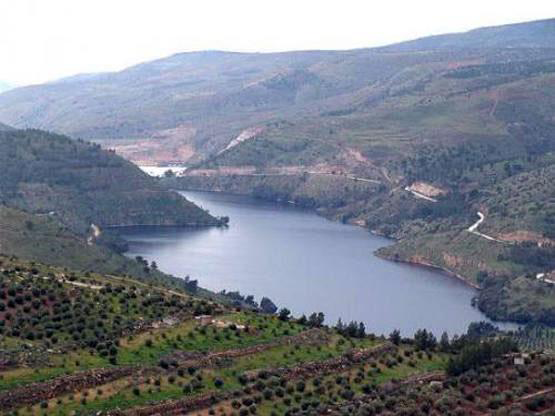You are here
‘25 per cent of Jordan’s long-term annual average of rainfall has been realised so far’
By Hana Namrouqa - Dec 09,2018 - Last updated at Dec 09,2018

In this undated photo, an aeriel view of the King Talal Dam in Jerash, some 50km north of Amman, can be seen (Photo courtesy of the Ministry of Water and Irrigation)
AMMAN — The Kingdom's 14 major dams now hold 28 per cent of their total capacity, according to the Ministry of Water and Irrigation, which indicated that the country has thus far received much higher rainfall compared to this time last year.
The ministry's figures on Saturday indicated that two dams have already reached their total capacity and overflowed, including the 1.7-million cubic metre (mcm) Wadi Shuaib Dam, which overflowed on Friday, and the 9.3-mcm Waleh Dam, which reached its maximum capacity almost exactly last month, but did not receive floodwater during this depression.
Minister of Water and Irrigation Raed Abul Saud said in a statement to The Jordan Times that the country has received 1 billion cubic metres of rain between Thursday and Saturday morning.
He also said that that the rain over the weekend pushed the amount of rain that Jordan received since the start of the wet season, which authorities recognise as late September to early October, to 2.045 billion cubic metres.
“A total of 25 per cent of the country’s long-term annual average of rainfall, which stands at 8.1 billion cubic metres, has been realised so far,” Abul Saud said in the ministry’s statement.
The country was affected on Thursday by a depression which brought constant, heavy rain to almost all parts of the country.
Between Thursday and Saturday morning, the major dams received 7.7mcm of water, raising dams' storage to 95mcm of their total capacity of 325mcm, according to the ministry.
The storage of the dams is also higher compared to what they held during this time last year, according to ministry’s spokesperson, Omar Salameh.
“During this time last year, the country’s major dams held 61mcm or 18 per cent of their total capacity,” Salameh told The Jordan Times. However, newly-constructed dams entered this year the ministry’s list of operating dams, such as the Wadi Zarqa-Maeen Dam.
Rain this year has arrived early, according to meteorologists at the Jordan Meyeorological Department (JMD), who indicated that weather charts show that the region will be affected with several depressions this winter, with sufficient rain expected.
Impact of the depression was forecasted to subside by Saturday night, according to the JMD, which indicated that, while a slight rise in temperatures is forecast for Sunday, while partly cloudy and chilly weather will continue to prevail.
Temperatures on Sunday and Monday will range between a high of 14oC and a low of 8oC at night in Amman, while on Tuesday, the weather will become cloudy, with a chance of scattered showers in the north of the Kingdom, according to the JMD.
Related Articles
AMMAN — Recent rainfall has elevated water levels in 15 major dams in the Kingdom to 68,503 million cubic metres (mcm), according to The Min
AMMAN — For the first time since its construction over four decades ago, the King Talal Dam in Jerash overflowed thrice during the same wet
Rainfall over the past two days dispelled fears of a looming drought this year, with some five million cubic metres (mcm) of water entering the dams between late Tuesday and early Wednesday, according to officials.



















